
The Aga Khan Award for Architecture (AKAA) is an architectural prize established by Aga Khan IV in 1977. It aims to identify and reward architectural concepts that successfully address the needs and aspirations of Muslim societies in the fields of contemporary design, social housing, community development and improvement, restoration, reuse and area conservation, as well as landscape design and improvement of the environment.
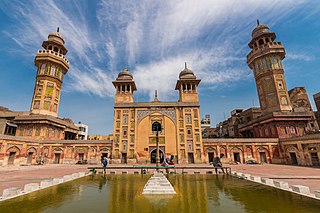
The Wazir Khan Mosque is a 17th-century mosque located in the city of Lahore, capital of the Pakistani province of Punjab. The mosque was commissioned during the reign of the Mughal Emperor Shah Jahan as a part of an ensemble of buildings that also included the nearby Shahi Hammam baths. Construction of Wazir Khan Mosque began in 1634 C.E., and was completed in 1641. It is on the UNESCO World Heritage Tentative List.

Humayun's tomb is the tomb of the Mughal Emperor Humayun in Delhi, India. The tomb was commissioned by Humayun's first wife and chief consort, Empress Bega Begum under her patronage in 1558, and designed by Mirak Mirza Ghiyas and his son, Sayyid Muhammad, Persian architects chosen by her. It was the first garden-tomb on the Indian subcontinent, and is located in Nizamuddin East, Delhi, India, close to the Dina-panah Citadel, also known as Purana Qila, that Humayun found in 1538. It was also the first structure to use red sandstone at such a scale. The tomb was declared a UNESCO World Heritage Site in 1993, and since then has undergone extensive restoration work, which is complete. Besides the main tomb enclosure of Humayun, several smaller monuments dot the pathway leading up to it, from the main entrance in the West, including one that even pre-dates the main tomb itself, by twenty years; it is the tomb complex of Isa Khan Niyazi, an Afghan noble in Sher Shah Suri's court of the Suri dynasty, who fought against the Mughals, constructed in 1547 CE.

Iranian architecture or Persian architecture is the architecture of Iran and parts of the rest of West Asia, the Caucasus and Central Asia. Its history dates back to at least 5,000 BC with characteristic examples distributed over a vast area from Turkey and Iraq to Uzbekistan and Tajikistan, and from the Caucasus to Zanzibar. Persian buildings vary from peasant huts to tea houses, and garden pavilions to "some of the most majestic structures the world has ever seen". In addition to historic gates, palaces, and mosques, the rapid growth of cities such as the capital Tehran has brought about a wave of demolition and new construction.

The Aga Khan Development Network (AKDN) is a network of private, non-denominational development agencies founded by the Aga Khan that work primarily in the poorest parts of Asia and Africa. Aga Khan IV succeeded to the office of the 49th hereditary Imam as spiritual and administrative leader of the Shia faith-rooted Nizari Ismaili Muslim supranational union in 1957. Ismailis consist of an estimated 25–30 million adherents.

The National Museum of Malí is an archaeological and anthropological museum located in Bamako, the capital of Mali. It presents permanent and temporary exhibits on the history of Mali, as well as the musical instruments, dress, and ritual objects associated with Mali's various ethnic groups.
The Aga Khan Trust for Culture (AKTC) is an agency of the Aga Khan Development Network (AKDN), a family of institutions created by Aga Khan IV with distinct but complementary mandates to improve the welfare and prospects of people in the developing world, particularly in Asia and Africa. It focuses on the revitalization of communities in the Muslim world—physical, social, cultural, and economic. The AKTC was founded in 1988 and is registered in Geneva, Switzerland, as a private non-denominational philanthropic foundation.
The Historic Cities Programme (HCP) of the Aga Khan Trust for Culture (AKTC) promotes the conservation and re-use of buildings and public spaces in historic cities of the Muslim world. HCP undertakes the restoration and rehabilitation of historic structures and public spaces in ways that can spur social, economic and cultural development. Individual projects go beyond technical restoration to address the questions of the social and environmental context, adaptive reuse, institutional sustainability and training. In several countries, local Aga Khan Cultural Service companies have been formed to implement projects under the supervision of the HCSP headquarters in Geneva.

The Aga Khan Museum is a museum of Islamic art, Iranian (Persian) art and Muslim culture located at 77 Wynford Drive in the North York district of Toronto, Ontario, Canada. The museum is dedicated to Islamic art and objects, and it houses approximately 1,200 rare objects assembled by His Highness the Aga Khan and Prince Sadruddin Aga Khan. As an initiative of the Aga Khan Trust for Culture, an agency of the Aga Khan Development Network, the museum is dedicated to presenting an overview of the artistic, intellectual, and scientific contributions that Muslim civilizations have made to world heritage. In addition to the Permanent Collection, the Aga Khan Museum features several temporary exhibitions each year that respond to current scholarship, emerging themes, and new artistic developments. The Museum Collection and exhibitions are complemented by educational programs and performing arts events.
Ramses Wissa Wassef (1911–1974) was an Egyptian Coptic architect and professor of art and architecture at the College of Fine Arts in Cairo and founder of the Ramses Wissa Wassef Art Centre.
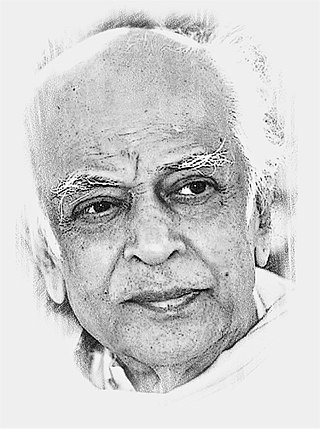
Muzharul Islam was a Bangladeshi architect, urban planner, educator and activist. He is considered as the Grand Master of regional modernism in South Asia. Islam is the pioneer of modern architecture in Bangladesh and the father of Bengali modernism. Islam's style and influence dominated the architectural scene in the country during the 1960s and 70s, along with major US architects he brought to work in Dhaka.

Jamel Akbar is an architect, educator, and theorist. His theoretical contributions are in the field of the built environment. His major contribution is in measuring the quality of the built environment through concepts such as responsibility, control, ownership and interventions. His work concentrates on humans' and properties’ rights among individuals, institutions and the State. By comparing such rights in different cultures he developed conclusions concerning economic and social settings and their ramifications on the quality of the built environment.
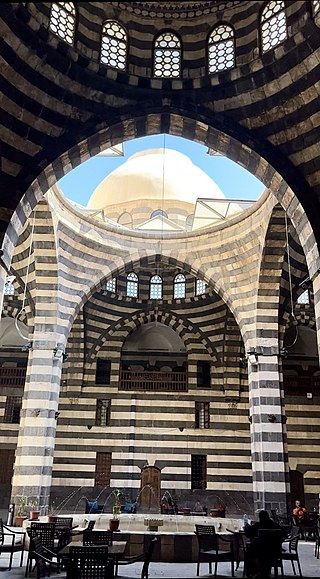
Khan As'ad Pasha is the largest caravanserai in the Old City of Damascus, covering an area of 2,500 square metres (27,000 sq ft). Situated along Al-Buzuriyah Souq, it was built and named after As'ad Pasha al-Azem, the governor of Damascus, in 1751–52. Khan As'ad Pasha has been described as one of the finest khans of Damascus, and the most "ambitious" work of architecture in the city. Throughout the Ottoman era, it hosted caravans coming from Baghdad, Mosul, Aleppo, Beirut and elsewhere in the Middle East.
Arif Hasan, is a Pakistani architect, planner, activist, social researcher, and writer. He is a recipient of Hilal-i-Imtiaz, the country's highest award for its citizens.
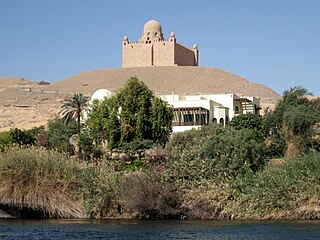
The Mausoleum of Aga Khan is the mausoleum of Aga Khan III, Sir Sultan Muhammed Shah, who died in 1957. The mausoleum is located at Aswan along the Nile of Egypt, since Egypt was formerly the centre of power of the Fatimids, an Ismaili Shia dynasty.
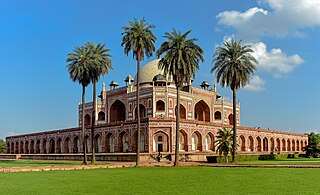
Ratish Nanda is a noted Indian conservation architect, who is the Projects Director of Aga Khan Trust for Culture, India.

The Shahi Hammam, also known as the Wazir Khan Hammam, is a Persian-style bath which was built in Lahore, Pakistan, in 1635 C.E. during the reign of Emperor Shah Jahan. It was built by chief physician to the Mughal Court, Ilam-ud-din Ansari, who was widely known as Wazir Khan. The baths were built to serve as a waqf, or endowment, for the maintenance of the Wazir Khan Mosque.
Renata Holod is an American art historian, architecture historian and archaeologist, specializing in the Islamic world. She is the College for Women Class of 1963 Term Professor in the Humanities in the History of Art Department, and Curator of the Near East Section, Museum of Archaeology and Anthropology at the University of Pennsylvania. Holod has taught at University of Penn since 1972, and was a visiting Clark Professor at Williams College in 2002. She has conducted and/or directed archaeological fieldwork in Iraq, Afghanistan, Syria, Iran, Morocco, Turkey, Ukraine, and Tunisia.

The Ismaili Centre, Vancouver is one of six such centres worldwide. It was the first purpose-built Ismaili jamatkhana and the first Ismaili centre in North America. It has accordingly been the subject of sustained, dedicated academic analysis, being noted as a case-study of modern Islamic architecture in the West.
















